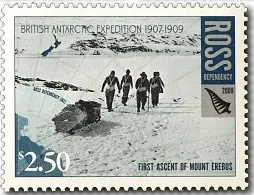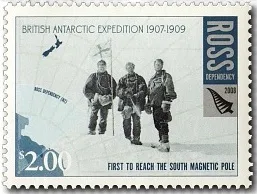Each year the Ross Dependency issues a set of stamps, used for postage but also aimed at the collector market. The subjects shown either relate to the history, scenery or wild life of the dependency.
The 2008 Ross Dependency stamp issue marked the 100th anniversary of the British Antarctic Expedition 1907 - 1909. The issue consisted of five values showing scenes from various stages of the expedition. In this post, the stamps have been arranged as how they fit into the story, rather than by value as we usually do. They can be seen arranged by value in the strip above.
The British Antarctic Expedition 1907 - 1909, also known as the Nimrod Expedition, was the first of three expeditions to the Antarctic led by Ernest Shackleton. It was financed without governmental or institutional support and relied on private loans and individual contributions. Its ship, Nimrod, was a small, 40-year-old wooden sealer of 334 gross register tons, and the expedition's members generally lacked relevant experience. On New Year’s Day 1908, Nimrod departed from the South Island port of Lyttelton.
The British Antarctic Expedition 1907 - 1909, also known as the Nimrod Expedition, was the first of three expeditions to the Antarctic led by Ernest Shackleton. It was financed without governmental or institutional support and relied on private loans and individual contributions. Its ship, Nimrod, was a small, 40-year-old wooden sealer of 334 gross register tons, and the expedition's members generally lacked relevant experience. On New Year’s Day 1908, Nimrod departed from the South Island port of Lyttelton.
50c - Departure of Nimrod from Lyttelton / 1 January 1908.
Initially, the expedition's public profile was much lower than that of Scott’s Discovery Expedition six years earlier. However, nationwide interest was aroused by the news of its achievements. The South Pole was not attained, but the expedition’s southern march reached the farthest south latitude of 88 degrees 23 minutes, and the expedition could claim that it had got within one hundred miles of the Pole. This was by far the longest southern polar journey to that date.
$1.00 - Pre-fabricated Expedition Base Hut / Cape Royds.
During the expedition, a separate group led by Welsh Australian geology professor Edgeworth David reached the estimated location of the South Magnetic Pole, and the first ascent was made of Mount Erebus, Ross Island's active volcano. The scientific team carried out extensive geological, zoological and meteorological work.
During the expedition, a separate group led by Welsh Australian geology professor Edgeworth David reached the estimated location of the South Magnetic Pole, and the first ascent was made of Mount Erebus, Ross Island's active volcano. The scientific team carried out extensive geological, zoological and meteorological work.
$2.50 - First ascent of Mount Erebus / 9 March 1908.
$2.00 - First to reach the South Magnetic Pole / 16 January 1909.
Shackleton’s transport arrangements, based on Manchurian ponies, motor traction and sled dogs, were innovations which were later copied by Scott for his ill-fated Terra Nova Expedition.
$1.50 - First Vehicle on the Continent.
The expedition was a public triumph, although in the eyes of some of the London geographical establishment its successes were compromised because Shackleton had broken a promise made under duress to Scott that he would not base his winter quarters in or near McMurdo Sound. Ice conditions had ultimately forced Nimrod to land there.
On his return, Shackleton survived the Royal Geographical Society's scepticism about his achievements and received many public honours, including a knighthood from King Edward VII. Within three years his farthest south record had been surpassed, as first Amundsen and then Scott reached the South Pole. In his own moment of triumph Amundsen recognized: "Sir Ernest Shackleton's name will always be written in the annals of Antarctic exploration in letters of fire".
The expedition was a public triumph, although in the eyes of some of the London geographical establishment its successes were compromised because Shackleton had broken a promise made under duress to Scott that he would not base his winter quarters in or near McMurdo Sound. Ice conditions had ultimately forced Nimrod to land there.
On his return, Shackleton survived the Royal Geographical Society's scepticism about his achievements and received many public honours, including a knighthood from King Edward VII. Within three years his farthest south record had been surpassed, as first Amundsen and then Scott reached the South Pole. In his own moment of triumph Amundsen recognized: "Sir Ernest Shackleton's name will always be written in the annals of Antarctic exploration in letters of fire".
Technical Information.
NZ Post has removed some Ross Dependency issues from their website so for the years 2007 through 2010 there will be no technical information and details concerning the scenes shown on each stamp, will be gained from other sources.
Some of the images in this post were used with permission from the illustrated catalogue of StampsNZ
You can visit their website and Online Catalogue at, http://stampsnz.com/
Information for this post came from.






We appreciate your engagement with our content. To ensure a respectful and constructive community, please take note of the following:
- No Spam, Please: We do not tolerate spammy or promotional comments. Any such comments will be promptly removed.
- Moderation in Place: All comments are moderated to maintain a positive and inclusive environment. Please be patient, as it may take a little time for your comment to appear.
- Sign In with Google: To comment, please sign in using your Google account. This helps us maintain the integrity of our community and allows for better interaction.